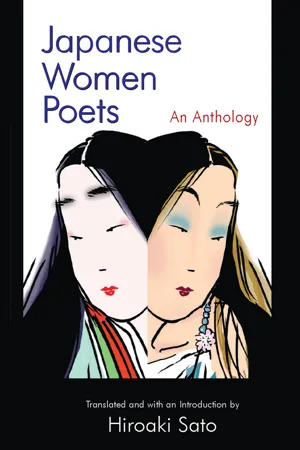
- 592 pages
- English
- ePUB (mobile friendly)
- Available on iOS & Android
About This Book
Throughout history, Japanese women have excelled in poetry - from the folk songs of the Kojiki (Record of Ancient Matters) compiled in 712 and the court poetry of the 9th to the 14th centuries, on through the age of haikai and kanshi to the 19th century, into the contemporary period when books of women's poems have created a sensation.This anthology presents examples of the work of more than 100 Japanese women poets, arranged chronologically, and of all the major verse forms: choka, tanka, haikai (haiku), kanshi (verse written in Chinese), and free verse. The poems describe not just seasonal changes and the vagaries of love - which form the thematic core of traditional Japanese poetry - but also the devastations of war, childbirth, conflicts between child-rearing and work, experiences as refugees, experiences as non-Japanese residents in Japan, and more.Sections of poetry open with headnotes, and the editor has provided explanations of terms and references for those unfamiliar with the Japanese language. Other useful tools include a glossary of poetic terms, a chronology, and a bibliography that points the reader toward other works by and about these poets. There is no comparable collection available in English.Students and anyone who appreciates poetry and Japanese culture will treasure this magnificent anthology. Editor and translator Hiroaki Sato is a past winner of the PEN America translator prize and the Japan-United States Friendship Commission's 1999 literary translation award.
Frequently asked questions
Information
The Modern Age
At long last, the time for new poetry has come.It is like a beautiful dawn. Some shout like ancient prophets, some call out like poets of the West, all as though intoxicated with a bright light, a new voice, and imagination.Youthful imagination, awakened from a long sleep, adorns the language of our folk.…Many in the throng of new singers are just simple youths. Their art is childish, imperfect, and yet also without falsity, without embellishment.…It is said that poetry is “emotion recollected in tranquillity.” Indeed, my songs are confessions of fearful struggles.Grief and suffering remain in my songs. When you think of it, it is good to speak out. It’s good to speak out without hesitation.…
Yosano Akiko
(1878–1942)
Cochineal Purple
Table of contents
- Cover
- Half Title
- Title Page
- Copyright Page
- Dedication
- Brief Contents
- Table of Contents
- Note and Acknowledgments
- Chronology
- Twelve Months
- Introduction
- Ancient Songs
- Poems from the Man’yōshū
- The Age of Tanka
- The Age of Haikai and Kanshi
- Interludes
- The Modern Age
- Japanese Verse Forms and Poetic Terms
- Bibliography
- Index of Poets
- About the Translator